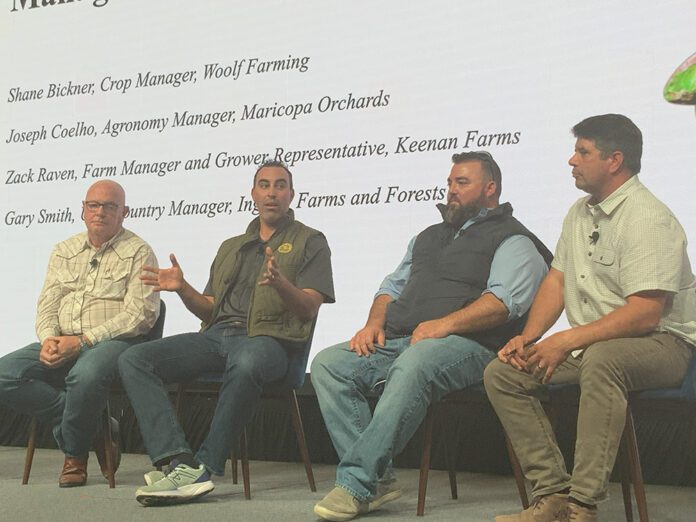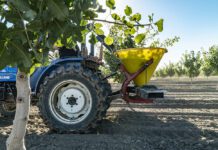
Minimizing soil surface disturbance, maximizing soil cover and promoting conditions for viability of soil critters, including bacteria, fungi and earthworms, are the main emphasis of the Healthy Soils program.
With the award of a $5 million grant to American Pistachio Growers (APG) to promote soil health practices, pistachio growers are deciding which practices they can incorporate in their operations to meet the goals of the program and realize a return on investment.
Sessions at the annual APG conference focused on soil health and why it makes sense to integrate soil-building practices in pistachio orchards.
The soil health seminar and grower panel were focused on adding to grower understanding of the benefits of soil carbon in the form of organic matter (OM) and also suggested grant-supported practices growers can adopt to assess their benefits in pistachio production.
Speaker Bob Beede, UCCE farm advisor emeritus, reminded growers improving soil health is a process, not a single event. Soil health improvement can be made over time, he said, with supplementation of OM via native or planted cover crops, animal manure or compost applications. These can lead to a significant gain in soil carbon, which has many benefits to the structure and biological activity in the soil.
Soil carbon in the form of OM benefits the soil by supporting biological activity including beneficial fungi such as mycorrhizae. OM also supports earthworm activity and higher levels of actinomycetes, a gram-positive bacterium. Beede said OM also stores and cycles nutrients and increases soil aggregation and water holding capacity.
Panel Provides Practical Advice
The conference hosted a panel of farm managers and pistachio growers who highlighted practices they are using in their orchards to improve soil health.
“It’s all about becoming efficient at whatever you are doing,” said Zack Raven, a grower in the Laton area and manager for Keenan Farms. Keenan Farms takes a more conventional approach, applying nitrogen fertilizers at the right time and at the right rate. Compost applications are incorporated into the fertilizer program, and Raven said they are seeing positive results from the first application in an orchard two years ago. While the compost applications augment use of CAN-17 and UN-32, he said they are seeing an increase in soil OM and improved water infiltration.
“If we can cut fertilizer costs by 20% using compost, that is a huge savings,” Raven said. Compost applications continued on Keenan Farms pistachio orchards last year. Adding the organic material is a cheaper and more natural way to release N into the soil, Raven said. So far, he reports positive results, particularly with water infiltration.
Raven said the compost is sourced from a certified dealer as specified in the Healthy Soils Incentive Program. By using more soil amendments based on soil tests, Raven said they are adapting more regenerative farming practices with the opportunities provided by the Healthy Soils grant, but still see the benefits of combining those with old school to produce good crops.
Shane Bickner, farming manager at Woolf Farming in Huron, said cover crops have helped with water percolation challenges in orchards. After three years of drought from 2020-22, he saw soil electrical conductivity rising and said the solution has been cover crops.
The cover crop was flown on a mature Kerman on PG1 rootstock. The original intention, Bickner said, was to improve percolation, but with groundwater at 1800 lbs. sodium/ac-ft, the target became sodium reduction. First year with the cover crop drastically reduced standing water in the orchard, but 30 years of preemergent use was difficult to overcome. In 2022, the crop came on, and Bickner needed a herd of hungry goats to graze it down. Last year’s rainfall spurred huge growth, and Bickner said the plan is to keep the cover crop going because it eliminates four herbicide applications, saving $200 per acre. Pest insects have been noted as a problem with green cover crops, but Bickner said even with high lygus populations, the bugs stay in the cover crop. An added bonus is decomposition of mummy nuts in the green cover crop.
“Six months out of the year, it’s the best thing. By summertime, it’s ugly,” Bickner said.
Pistachio grower and manager at Maricopa Orchards and Terra Linda Farms Joe Coelho said a search for economical weed control in organically grown pistachios led him to try several methods: weed mats, propane burning and organic approved herbicides. None, he said, were economically viable.
Turns out a flock of sheep solved a couple problems for Coelho. They not only eliminated weeds, they also chomped down the mummy nuts that were on the ground.
“They prefer the weeds, but when that runs out they will eat the mummies,” he said. The sheep preferred to eat the mummies immediately after harvest when the nuts were fresh, opposed to late winter when they were decayed.
Coelho took part in a California Pistachio Research Board project on the impacts of sheep grazing on pistachio orchard sanitation. The first year of the research, led by UCCE Entomology Specialist Houston Wilson, reported on average there was about a 25% reduction in mummy densities following grazing. The study also found grazing reduced the groundcover biomass.
Coelho said he has also made efforts to reduce orchard tillage, mainly in conventional orchards.
“One of the simplest things you can do is just go to no-till in the centers,” he said. Center can be mowed throughout the season, particularly prior to stages that vegetation might attract pests, leaving plant carbon residue behind for a variety of benefits, while some traditional weed control on berms may continue.
In his own blocks, he said they have planted wheat and oat crops in the middles of non-bearing pistachios. Rather than deep discing after harvest, he said they have successfully drilled seed back into the stubble for the next crop. The plan, he said, is to continue even with revenue-generating grain crops until larger equipment such as bailers and swathers no longer fit under the tree canopy, establishing a volunteer seed bank that can be lightly reseeded with grasses such as Blando Brome to maintain a vegetated center.
When it comes to nutrition, Coelho said economics proven through research will drive the willingness of growers to adopt soil-building practices. High yields can still be achieved with sustainable practices in pistachio production. Compost applications, carbon residue from cover crops, carbon-based fertilizers and amendments contribute to greater N use efficiency, soil health and replacement of traditional inputs.
“Pistachios have strong potential to lean into sustainable practices,” Coelho said. “If you show the economics and feasibility to growers, that is when adoption of practices takes place.”











